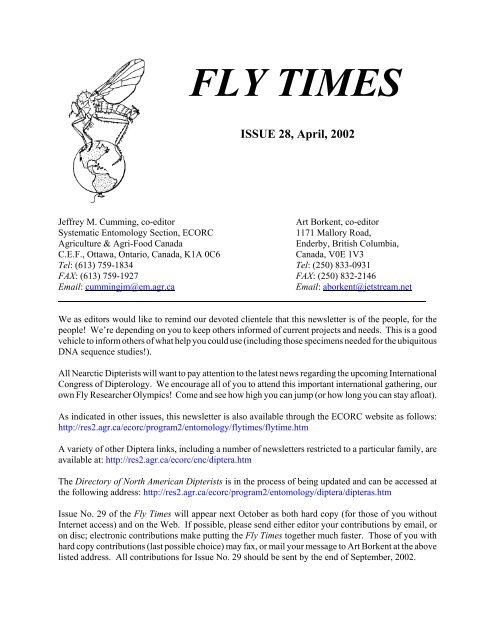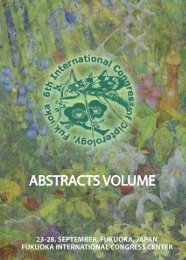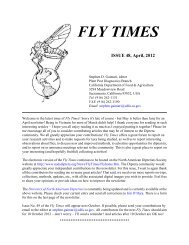Fly Times Issue 28, April 2002 - North American Dipterists Society
Fly Times Issue 28, April 2002 - North American Dipterists Society
Fly Times Issue 28, April 2002 - North American Dipterists Society
- No tags were found...
Create successful ePaper yourself
Turn your PDF publications into a flip-book with our unique Google optimized e-Paper software.
2NEWS5th International Congress of DipterologyThe University of Queensland, Brisbane, Australia29 September - 4 October <strong>2002</strong>by David YeatesChair, Organizing CommitteeCSIRO Entomology, Clunies Ross St., Acton, ACT 2601, AustraliaThe Organizing Committee of the 5th International Congress of Dipterology is pleased to advise that theRegistration Brochure and Call for Papers is now available at the Congress web sitehttp://www.uq.edu.au/entomology/dipterol/diptconf.htmlReaders are reminded of the following important dates:<strong>April</strong> 15: Deadline for receipt of funding support applications<strong>April</strong> 30: Deadline for early registration<strong>April</strong> 30: Deadline for receipt of abstractsJune 15: Notification of abstract acceptanceFurther details are also available by contacting Sally Brown, Conference Connections, at her emailaddress: sally.brown@uq.net.au or PO Box 108 Kenmore QLD 4069 Australia Telephone +61 7 3201<strong>28</strong>08 Fax +61 7 3201 <strong>28</strong>09 Mobile 0407 178 200. http://www.uq.net.au/conferenceconnections/Progress toward organizing the 5th Congress of Dipterology is building in intensity. The secondannouncement was mailed in late February, and this information is mirrored on the Congress web site(www.uq.edu.au/entomology/dipterol/diptconf.html). The second announcement contains details of thescientific program, including the plenary speakers, symposia and workshops that have been organizedto date. Other abstracts received will be organized into contributed paper sessions. These sessions willbe organized according to the nature of the abstracts received by the organizing committee, and will beannounced on the web site in May.Thanks to all those who have already registered: the deadline for early bird registration is 30th <strong>April</strong>. Thesecond announcement brochure contains information on the scheme to support delegates attendance atthe Congress. Applications for this support close on 15th <strong>April</strong>. For more information or copies of thesecond announcement brochure please contact Sally Brown (address above). On behalf of the OrganizingCommittee we look forward to seeing you at the Congress!
5NADS Meetings at ESA in San DiegoDecember, 9-13, 2001by Brian BrownNatural History Museum of Los Angeles County, 900 Exposition BoulevardLos Angeles CA 90007, USAAbout 35 people attended the Dipterological gathering at the last ESA meeting. Three talks were given:J. E. O'Hara. Review and phylogenetics of the Polideini, a remarkably diverse tribe of Tachinidae.C. R. Nelson. Flies on the Grand Staircase: collecting on the Colorado Plateau of southern Utah.B. V. Brown. Characterization of an assemblage of parasitic bee-killing flies, genus Melaloncha(Phoridae).Jon Gelhaus showed some slides of his collecting trip to Mongolia.***************************************Larry Quate Passes Awayfrom Brian BrownNatural History Museum of Los Angeles County, 900 Exposition BoulevardLos Angeles CA 90007, USAIt is with great sadness that I inform you that Dr. Laurence W. Quate passed away on Tuesday, Jan. 15,<strong>2002</strong>, after a protracted battle with cancer. Larry was a world authority on the family Psychodidae(Diptera), and was beloved by all for his warm, friendly personality, as well as his great knowledge ofand enthusiasm for his flies. I am working with Larry's widow to deal with his entomological material.If you have questions about outstanding loans, or other issues pertaining to his scientific work, pleasedirect them to me.***************************************Needed: Help with Getting the Jump on Frog Biting Midgesby Art Borkent1171 Mallory Rd., Enderby, British Columbia, V0E 1V3I am in the middle of a world revision of Corethrella, the sole genus in the Corethrellidae. I have foundthat virtually every sample around the globe includes undescribed species (e.g. 2 specimens fromSarawak = 2 undescribed species). Obviously the genus is actually much larger than the 64 speciespresently recognized. I would therefore ask anyone who has material in their collection to contact meregarding the loan of their specimens; even a single specimens would be of value.
6Request for Specimens: Dolichopodidae of the subfamily Achalcinaeby Marc PolletDept. of Entomology, Royal Belgian Institute of Natural SciencesVautierstraat 29 B-1000, Brussels, BelgiumPollet (1996) and Pollet & Cumming (1998) dealt with the Palaearctic and Nearctic Achalcus faunarespectively in papers published in Systematic Entomology. Since then, I have been gathering moreHolarctic material and recently started to examine the yields. All three examined species (Japan, Canada,USA) proved to be new to science and are currently described. In order to incorporate all Achalcusspecimens stored in both private and public collections, I very much like to invite anyone to send mespecimens. Any Achalcinae of any realm are most welcome (next to this "project", I am also finishinga manuscript on the Neotropical Achalcus fauna and will start a revision of Xanthina (excl. Neotropicalgenus). Any specimens in either 70% alcohol solution and dry would be great, although I prefer wet materialwhich considerably facilitates dissections. Anyone who collaborates with this project will be kept informedand will receive a reprint of the final paper. Specimens can be mailed to the above address.***************************************Dick Foote Passes AwayWe regret to report that Dick Foote passed away this past winter at the age of 83. He will be missed terribly.He died unexpectedly in his sleep early Saturday morning while recuperating from a hip fracture. A memorialservice was held on Monday, Feb 18, <strong>2002</strong>.***************************************Words of WisdomEvery community, as it matures, attempts to gather and preserve pearls of wisdom from the older generation,to provide light and direction for those who follow. Alternatively, these saying may be made into bumperstickers or be imprinted on tee shirts to be sold for a profit. In an attempt to stimulate this process, the editorsprovide the following from one our most eminent collectors, a truly great stalker of biodiversity.Dick Vockeroth’s codicil: "The best collecting is half way between where you work and where you thinkthe best collecting will be"If you know of further great truths or insights, feel free to send them on to the editors. You need not beeminent, you could even be imminent! After all, truths can also come from the mouths' of babes.***************************************Correction to <strong>Issue</strong> 27, October 2001The caption to "A Flash from the Past" photo, page 3, should read Dick Deonier instead of Guy Bush.Our apologies to Dick and Guy.
7Dixidae Left on the Shelffrom Art Borkent1171 Mallory Rd., Enderby, British Columbia, V0E 1V3Mike Peters has informed me that he officially retired from the University of Massachusetts at the endof 1997 and that he has given up all entomological activities. His holotypes and most paratypes havebeen deposited in the Smithsonian. There are some paratypes left at the University of Massachusetts andmany specimens representing a variety of species. Here are the genera and number of species left there:Dixa: 22 spp.; Dixella - 19 spp.; Meringodixa - 1 sp; Metadixa - 1 sp.***************************************Cranefly Culture Availableby Arthur ForerBiology Department York University Toronto, Ont M3J 1P3, CanadaWhile interested in crane flies in particular, I am not really a Dipterist: I am a cell biologist, who studies(and has studied) meiosis/mitosis in living cells. I have reared and worked with Nephrotoma suturalisfor almost 40 years now -- my original stock came from 7 larvae (from <strong>North</strong> Carolina) in the early 60s,so I have reared them through many generations. [I also have reared N. ferruginea, N. abbreviatta, andothers, using the same techniques.] Now that I am 65, and was compulsorily retired (though I still havemy lab and still hope to work for as long as I have a grant and lab space), I know that one of these yearsI will have to stop my cultures. I am quite happy to show anyone interested how to rear these flies andto give over a substock (now) or complete stock (later) if anyone in the Dipterist world has an interest.If you are interested write to me at the above address or phone: (416) 736-5398.***************************************Diptera from the Czech Republicfrom Miroslav BartákCzech University of Agriculture, Faculty of Agronomy, Department of Zoology and Fishery,165 21 Praha 6 - Suchdol, Czech Republic"Diptera of an industrially affected region (<strong>North</strong>-Western Bohemia, Bílina and Duchcov environs)"printed in two volumes (altogether 514 pages) has been published. Altogether, 2,887 species wereidentified, 224 are the first findings in the territory of Bohemia and 180 species represent first recordsfrom the Czech Republic. Distributional data are added to each species as well as index of relativeabundance in the Czech Republic and larval food preference. On the basis of these characters, thebiological value of the area as a whole is evaluated. The process of Diptera succession on restored orspontaneously revitalized localities is discussed. The first volume comprises the Nematocera and
8Brachycera (not including the Schizophora), totaling 43 families. The second volume deals with the restof Brachycera, i.e. Schizophora, Acalyptrata and Calyptrata, totaling 48 families. Each family is treatedas a separate chapter with short description of adults and immatures, biology and history of research inthe Czech republic.You may order both volumes on my E-mail address, the cost of both volumes is $20 US includingpostage. You receive them after payment to account No 0348332353556011 of the Commercial bank(Komer…n± banka), pp. 839, Na På±kop› 33, 11407 Praha 1.***************************************Preservation of DNA in Museum Specimensfrom Ho-Yeon Hanc/o Dr. Allen L. Norrbom Systematic Entomology Lab., USDA, ARS Building 005,Room 137, BARC-West 10300 Baltimore Avenue Beltsville, MD 20705-2350 USAThe following paper describes the affect of different preservatives on longevity of DNA in museumspecimens. It seems that mounting flies killed and/or preserved in ethyl acetate or formalin is disastrousfor the study of DNA. From my experience, chloroform has a similar negative affect against DNA. Onehundred percent ethanol, air-drying in a desiccator, and critical-point dried from alcohol all yielded goodresults after short and long-term storage, as did specimens from ethylene glycol. It seems that criticalpoint drying is the way to go.Dillon N., Austin AD, and E. Bartowsky. 1996. Comparison of preservation techniques for DNAextraction from hymenopterous insects. Insect Molecular Biology. 5(1):21-24***************************************Great Smoky Mountains National Park ATBI - Acalyptrate Dipteraby Joe B. Keiper,Curator of Invertebrate Zoology The Cleveland Museum of Natural History1 Wade Oval Dr. Cleveland, OH 44106, USABen Foote (Kent State University) and I have been collecting selected families of acalyptrate Diptera forthe Great Smoky Mountains National Park All-Taxa Biotic Inventory. We give a preliminary report hereon what we have collected and identified to date: Anthomyzidae, Chloropidae, Drosophilidae,Ephydridae, Heleomyzidae, Lauxaniidae, Otitidae, Pallopteridae, Periscelididae, Platystomatidae,Psilidae, Sciomyzidae, Sepsidae, Sphaeroceridae, and Tephritidae. We have so far identified nearly 100species. Within the park, Chloropidae is by far the most species-rich of these families; much of ourchloropid material remains undetermined. Chuck Parker (USGS) and Will Reeves (Clemson University)have been instrumental in supplying malaise trap material.
9Books and PublicationsBaker, R.H. and G.S. Wilkinson. 2001. Phylogenetic analysis of sexual dimorphism and eye-spanallometry in stalk-eyed flies (Diopsidae). Evolution 55:1373-1385.Brown, B.V. 2001. Flies, gnats and mosquitoes. pp. 815-826 In Encyclopedia of biodiversity, Vol.2,Academic Press.A very nice synopsis of the order, with numbers of species in each family, and descriptions ofa variety of life histories present in the orderde Carvalho, C. J. B. (ed.) (in press). Muscidae (Diptera) of the Neotropical Region: taxonomy.[Publication date expected by the end of <strong>April</strong> <strong>2002</strong>]This book has two chapters: Part I, Basal groups, by C. J. B. de Carvalho & M. S. Couri and PartII, Apical groups, by M.S. Couri & C. J. B. de Carvalho. The main scope of this book is toprovide means of identifying the Neotropical species of Muscidae, one of the families of Dipterawith more than 4000 species in the world. In the Neotropical Region, there are about 840 speciesdistributed in 84 genera, 80 of them in South America. Some species have great medical andveterinary importance, acting as vectors of many diseases and other species have considerableecological importance. Although muscid flies are very abundant in rural or semi-ruralenvironments, most of them are rarely noticed by man. An indirect goal of this book, is also toidentify weak points in our knowledge of muscid taxonomic and diversity for the neotropics (e.g.taxonomic problems, need of generic revisions, need of more collecting in some groups with fewknown species, among others). If you are interested in this book, please contact the Editora daUniversidade Federal do Paraná editora@cce.ufpr.br or the authors CJBC: cjbcarva@bio.ufpr.bror and MSC: mcouri@attgloba.netDisney, R.H.L. 2001. The preservation of small Diptera. Entomologist's Monthly Magazine 137:155-159.Nirmala, X., V. Hypsa and M. Zurovec. 2001. Molecular phylogeny of calyptratae (Diptera:Brachycera): The evolution of 18S and 16S ribosomal rDNAs in higher dipterans and their usein phylogenetic inference. Insect Molecular Biology 10:475-485.O'Hara, J.E. (in press). Revision of the Polideini (Tachinidae) of America north of Mexico. StudiaDipterologica. Supplement 10, 170 pp. [Publication date scheduled for 30 <strong>April</strong> <strong>2002</strong>]Pape, T. and P.H. Arnaud. 2001. Bezzimyia - a genus of native New World Rhinophoridae (Insecta,Diptera). Zoologica Scripta 30:257-297.Pont, A. 2001. The type-material of Diptera in the Staatliches Museum fur Tierkunde Dresden (Insecta).Part IV: Fanniidae and Muscidae. Entomologische Abhandlungen Dresden 59:455-492.
10Roh©…ek, J., S.A. Marshall, A.L. Norrbom, M. Buck, D.I. Quiros and I. Smith. 2001. World catalog ofSphaeroceridae (Diptera). 17 x 24 cm, 414 pages, 1 colour and 26 full-page black-and-whiteillustrations plus 5 original pen-and-ink drawings of "fly-art" as a bonus (all by JindåichRoh©…ek). Bound, with colour cover. ISBN 80-86224-21-X. Published by the Slezské zemskémuzeum, Opava, 2001. Price: 29 US $ plus postage.The first world catalog of Sphaeroceridae (lesser dung flies) has been prepared by aninternational team of six dipterists. It includes all taxa described in the family during 1800-2000.Altogether 1,344 valid species-group taxa and 124 genus-group taxa are recorded along with allsynonyms and published generic and subgeneric combinations. In addition, nomina nuda anddoubtful genera and species are listed. A number of new nomenclatural changes are proposed(one new name; one new suprageneric, five generic and 29 specific synonyms; 150 newcombinations; three species restituted from synonymy; two subspecific taxa elevated to specificstatus). One neotype and 26 lectotypes are designated. Taxa excluded from Sphaeroceridae arereviewed in detail. A history of taxonomic research on the family is outlined and its systematicposition and classification summarized. A total of 26 illustrations are provided, depictingcharacteristic representatives of the different subgroups of Sphaeroceridae. A world bibliographyof Sphaeroceridae, with a total of 1,386 references, is given.Contents: Introduction; Acknowledgements; History of taxonomic research on Sphaeroceridae;Systematic position and classification of Sphaeroceridae; Format of the catalog, bibliography andindex; Acronyms used in the catalog; New nomenclatural changes; Designations and notes onprimary type material; Taxa excluded from Sphaeroceridae; Catalog of Sphaeroceridae:Tucminae, Copromyzinae, Sphaerocerinae, Homalomitrinae, Limosininae, Doubtful genera andof Sphaeroceridae [unplaced to subfamilies], Unavailable generic and specific names proposedin Sphaeroceridae, Numbers of valid taxa of Sphaeroceridae in the catalog; Gallery ofSphaeroceridae; Bibliography; Index.Orders should be send to: Slezské zemské muzeum, Tyršova 1, CZ-746 46 Opava, CzechRepublicWheeler, W.C., M. Whiting, Q.D. Wheeler and J.M. Carpenter. 2001. The phylogeny of the extanthexapod orders. Cladistics 17:113-169.Woodley, N. E. 2001. A World Catalog of the Stratiomyidae (Insecta: Diptera). Myia 11: (6), 1-475.ISBN 90-5782-083-8 Published by the <strong>North</strong> <strong>American</strong> Dipterist's <strong>Society</strong> and BackhuysPublishers, Leiden, distributed by Backhuys: Backhuys Publishers PO Box 321 2300 AHLeiden The Netherlands www.backhuys.com price:$98.00 US
Submission Form for Directory of <strong>North</strong> <strong>American</strong> <strong>Dipterists</strong>11For those who have not yet sent in a synopsis of their interests for the Directory of <strong>North</strong> <strong>American</strong><strong>Dipterists</strong>, the following form is provided. Please restrict yourselves to no more than 20 words whenlisting the titles of your major projects and the animals you work with. Should any of you like to expandor modify your entries from the last list, use the form to indicate the changes.The information can be emailed, or the form completed and faxed or sent to the following address:Dr. J. M. Cumming,Systematic Entomology Program, ECORCAgriculture & Agri-Food Canada,K.W. Neatby Building, C.E.F.Ottawa, Ontario, CANADA, K1A 0C6FAX: (613) 759-1927Email: cummingjm@em.agr.ca***************************************Full name:FAX Number:Projects and taxa studied:Address:Email:Telephone Number:
















